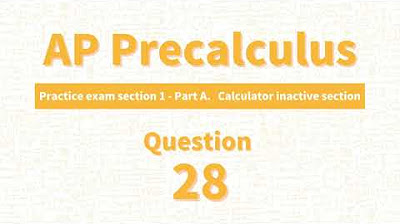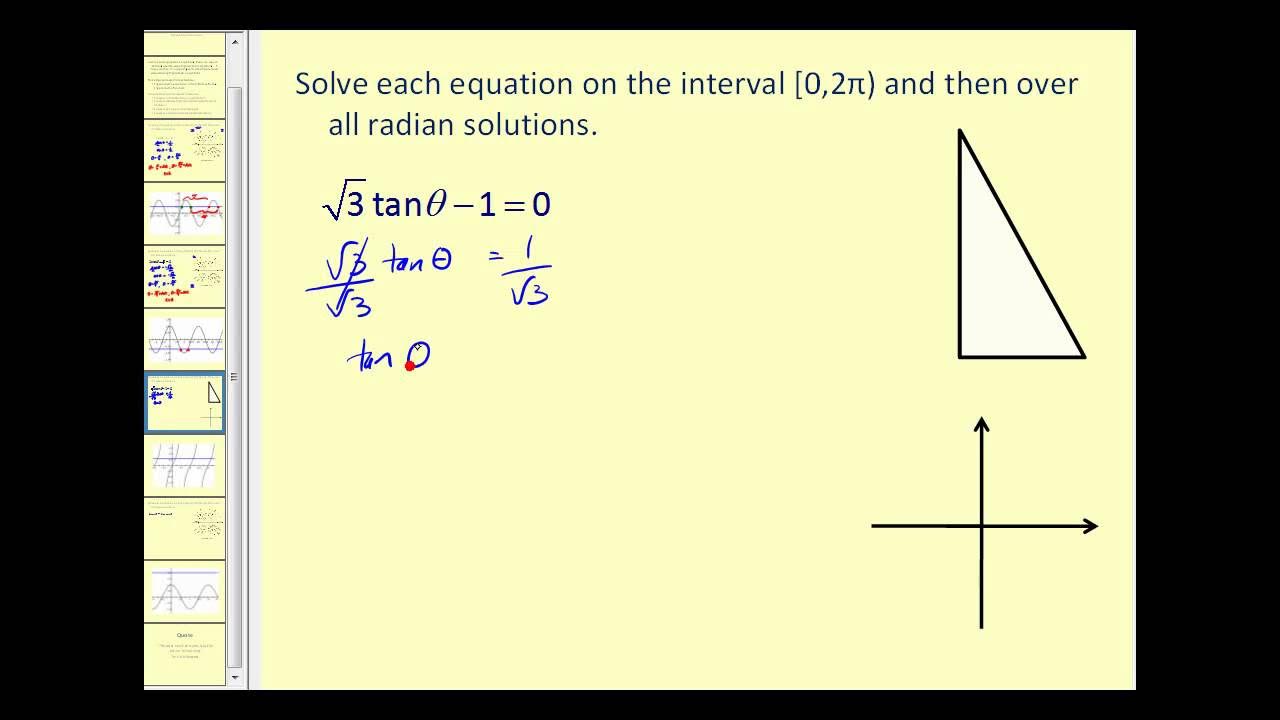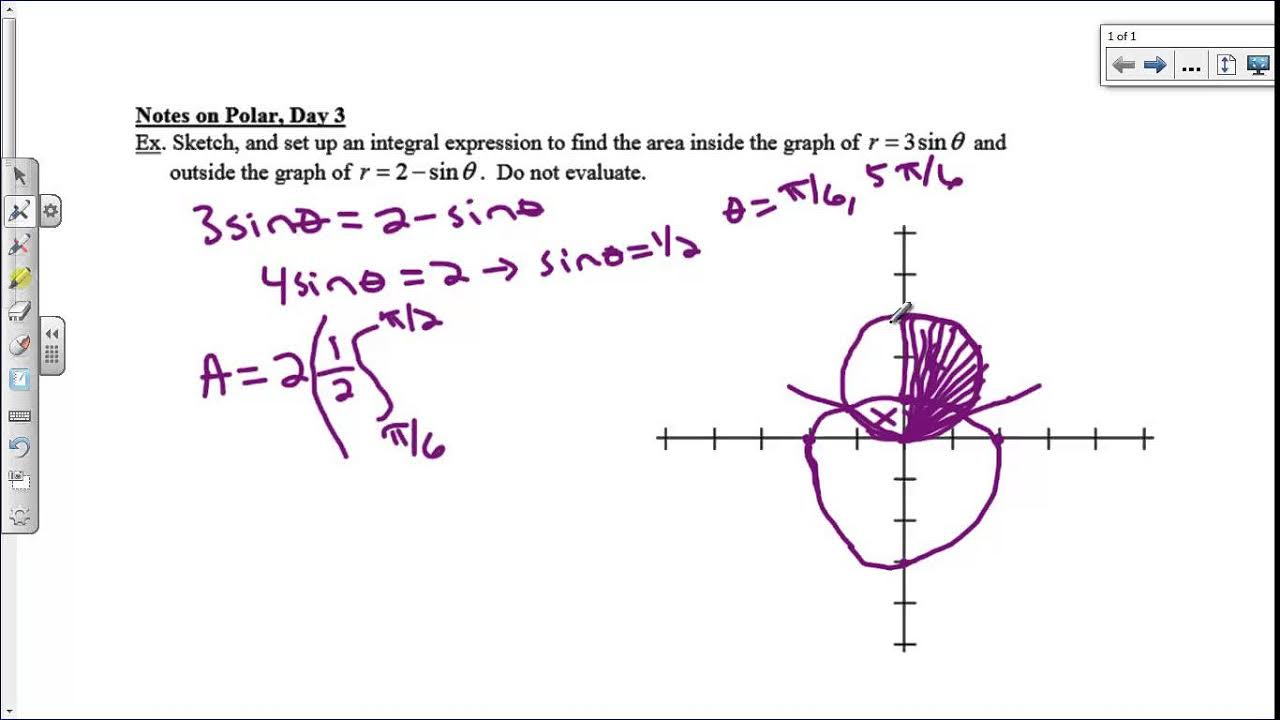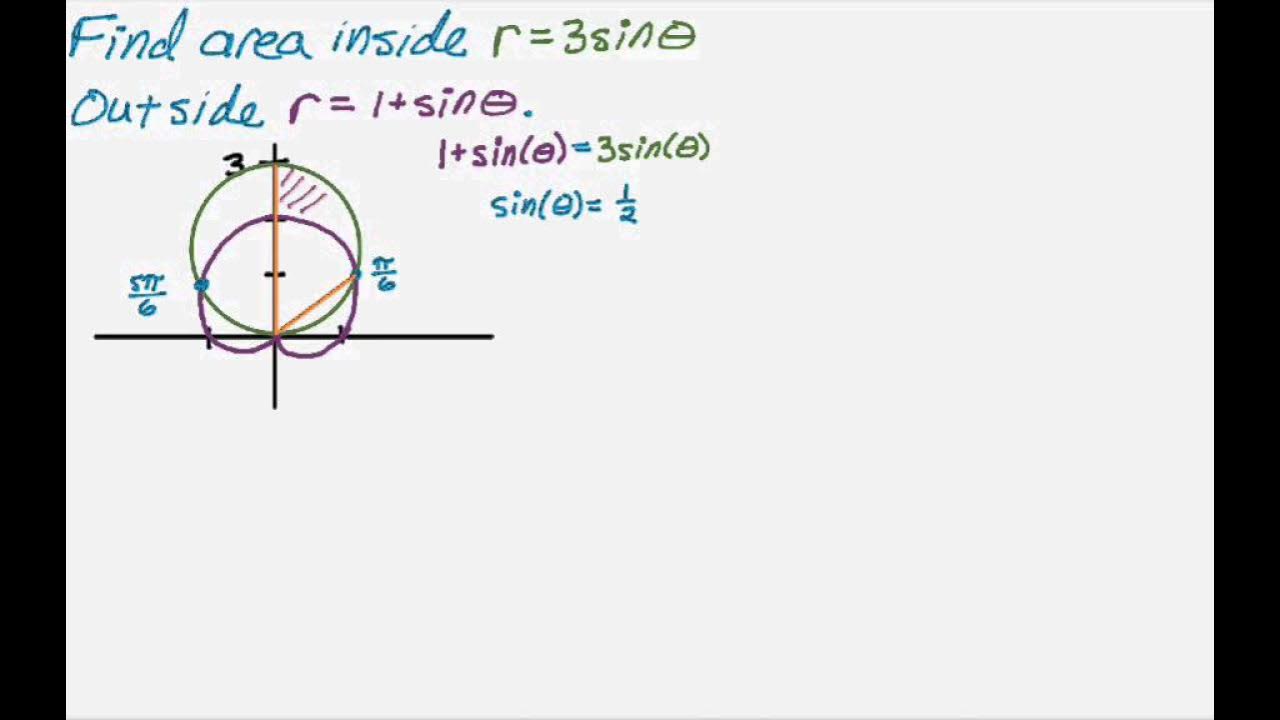AP Precalculus Practice Exam Question 25
TLDRThe video script explains how to solve the trigonometric equation 2sin²θ = -sinθ for θ in the range [0, 2π). The process involves rearranging the equation, factoring, and using the zero product property to find the solutions. The solutions are identified using the unit circle, resulting in θ values of 0, π, 7π/6, and 11π/6. The final correct solution set is confirmed as B.
Takeaways
- 🔍 The problem involves solving a trigonometric equation for values of theta where 0 ≤ θ < 2π.
- 📚 The equation given is 2 * sin²(θ) = -sin(θ), which is a quadratic in terms of sin(θ).
- 📝 The first step is to rearrange the equation to isolate terms, resulting in 2 * sin²(θ) + sin(θ) = 0.
- 🌟 Factoring is the chosen method to solve the equation, by taking out the common factor of sin(θ).
- 📉 After factoring, the equation simplifies to sin(θ) * (2 * sin(θ) + 1) = 0, using the zero product property.
- 🎯 The first factor gives the solution sin(θ) = 0, which occurs at θ = 0 and θ = π, within the given interval.
- 🧭 The second factor, 2 * sin(θ) + 1 = 0, is solved by isolating sin(θ) to get sin(θ) = -1/2.
- 📜 The unit circle is considered to find angles where sin(θ) = -1/2, which are θ = 11π/6 and θ = 7π/6.
- 📌 The solution set for θ includes the angles 0, π, 7π/6, and 11π/6, which satisfy the original equation.
- 🏁 The final correct solution set is identified as option B, which includes the angles found.
Q & A
What is the given trigonometric equation in the script?
-The given trigonometric equation is \(2 \sin^2(\theta) = -\sin(\theta)\) for \(0 \leq \theta < 2\pi\).
How does the script approach solving the trigonometric equation?
-The script approaches solving the equation by rearranging terms and factoring, aiming to apply the zero product property.
What is the first step taken to simplify the equation?
-The first step is to add \(\sin(\theta)\) to both sides, resulting in \(2\sin^2(\theta) + \sin(\theta) = 0\).
What common factor is extracted from the simplified equation?
-The common factor extracted is \(\sin(\theta)\), leading to the factored form \(\sin(\theta)(2\sin(\theta) + 1) = 0\).
According to the zero product property, how many solutions are expected for the equation?
-According to the zero product property, there are two potential solutions for the equation.
What are the two separate equations that result from applying the zero product property?
-The two separate equations are \(\sin(\theta) = 0\) and \(2\sin(\theta) + 1 = 0\).
What are the angles where \(\sin(\theta) = 0\) within the given interval?
-The angles where \(\sin(\theta) = 0\) within the interval \(0 \leq \theta < 2\pi\) are \(\theta = 0\) and \(\theta = \pi\).
How is the second equation \(2\sin(\theta) + 1 = 0\) solved for \(\sin(\theta)\)?
-The second equation is solved by subtracting 1 from both sides and then dividing by 2, resulting in \(\sin(\theta) = -\frac{1}{2}\).
What are the angles that satisfy \(\sin(\theta) = -\frac{1}{2}\) within the given interval?
-The angles that satisfy \(\sin(\theta) = -\frac{1}{2}\) within the interval are \(\theta = \frac{7\pi}{6}\) and \(\theta = \frac{11\pi}{6}\).
What is the final solution set for the given trigonometric equation?
-The final solution set is \(\theta = 0, \pi, \frac{7\pi}{6}, \frac{11\pi}{6}\).
What is the significance of the unit circle in solving this problem?
-The unit circle is significant as it helps determine the angles where the sine function equals zero and negative one-half, corresponding to the y-values on the circle.
Outlines
🧮 Solving Trigonometric Equation with Sine Functions
This paragraph explains how to solve the trigonometric equation 2sin^2(θ) = -sin(θ) for values of θ between 0 and 2π. The process begins by rearranging the equation to get zero on one side, resulting in a quadratic form. By factoring out the common term sin(θ), the equation is split into two separate equations: sin(θ) = 0 and 2sin(θ) + 1 = 0. Solving these individually, the solutions for sin(θ) = 0 are found at θ = 0 and π. For 2sin(θ) + 1 = 0, solving gives sin(θ) = -1/2, which corresponds to angles θ = 7π/6 and 11π/6 on the unit circle. Therefore, the complete set of solutions is θ = 0, π, 7π/6, and 11π/6, leading to the final answer choice B.
Mindmap
Keywords
💡Trig Equation
💡Factoring
💡Zero Product Property
💡Sine Function
💡Unit Circle
💡Angles
💡Quadratic
💡Solution Set
💡Pi
💡Radians
💡Negative One-Half
Highlights
Solving the trigonometric equation 2 * sin^2(theta) + sin(theta) = 0 within the range 0 ≤ theta < 2π.
Transforming the equation into a factorable quadratic form by adding sin(theta) to both sides.
Factoring out the common term sin(theta) to simplify the equation.
Applying the zero product property to find the solutions for sin(theta).
Determining that sin(theta) = 0 has solutions at theta = 0 and theta = π.
Finding the angle where sin(theta) = -1/2 by rearranging the equation.
Solving for sin(theta) = -1/2 to get two solutions, 11π/6 and 7π/6.
Considering the unit circle to determine the angles where sin(theta) equals zero and -1/2.
Identifying the angles on the unit circle corresponding to the sine values.
Excluding 2π from the solution set as per the given range.
Concluding the full solution set for theta as 0, π, 7π/6, and 11π/6.
Using the unit circle to visualize and confirm the solution angles.
Highlighting the importance of the zero product property in solving trigonometric equations.
Demonstrating the process of factoring and solving a trigonometric equation step by step.
Providing a clear explanation of how to handle the range restriction in the problem.
Emphasizing the methodical approach to solving trigonometric equations with quadratic forms.
Presenting a comprehensive solution to the given trigonometric problem with clear reasoning.
Finalizing the correct solution set for the problem, which is option B.
Transcripts
5.0 / 5 (0 votes)
Thanks for rating:





